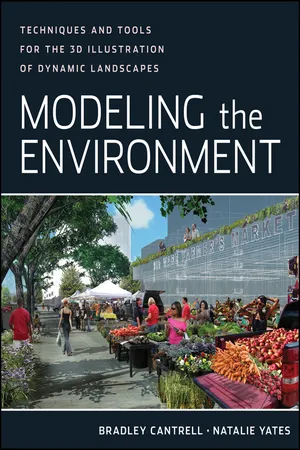
Modeling the Environment
Techniques and Tools for the 3D Illustration of Dynamic Landscapes
- English
- ePUB (mobile friendly)
- Available on iOS & Android
Modeling the Environment
Techniques and Tools for the 3D Illustration of Dynamic Landscapes
About This Book
A single-source guide to harnessing the power of 3D visualization tools for analysis and representation of landscapes
Current technology allows designers to model environmental phenomena and space in new and exciting ways that go beyond the two-dimensional plane. The models, illustrations, and animations that can be created usher in a new paradigm of landscape representation that can become analytical tools as well as beautiful imagery. The text focuses on digital modeling methods that can be used to express rich environments using digital tools to develop, composite, and animate scenes.
This full-color book provides coverage of 3D visualization tools for land planning and landscape architecture. The methods and theories in Modeling the Environment present landscape representation around a core set of ideas—scene, object, terrain, environment/atmosphere, time/dynamics, and the composite—that centers representation on human experience. Supported by www.lab.visual-logic.com, a website offering tutorials and forums, the text shows you how to use Autodesk 3ds Max to create dynamic landscape environments while also referring to a range of other tools including Google SketchUp, Autodesk Maya, and AutoCAD Civil 3D. It also demonstrates how to integrate 3D visualization tools into existing workflows, and offers critical coverage of intelligent drawings and representations, giving you a glimpse at the future of the profession. This book:
-
Includes sections intended to build upon one another in order to understand the environment as a composite representation of multiple systems interacting
-
Shows how to integrate 3D visualization tools into existing workflows, as opposed to offering an entirely new workflow
-
Emphasizes modeling, animation, and simulation as both design analysis tools and presentation tools
Modeling the Environment is essential reading for professionals in landscape architecture, urban planning and design, architecture, and related disciplines who are looking to be at the forefront of technology.
Frequently asked questions
Information
Table of contents
- Cover
- Title Page
- Copyright
- Foreword
- Preface
- Acknowledgments
- Part 1: Introduction
- Part 2: Scene
- Part 3: Object
- Part 4: Terrain
- Part 5: Atmosphere
- Part 6: Simulation
- Part 7: Composite
- Bibliography
- Image Credits
- Index